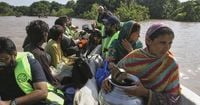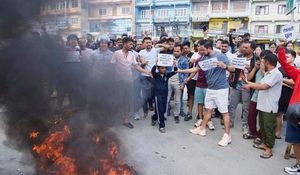In a harrowing testament to the power of nature and the resilience of communities, the eastern city of Jalalpur Pirwala in Pakistan’s Punjab province has become the epicenter of one of the largest flood evacuation efforts in recent memory. Over the course of a single night, from September 7 into September 8, 2025, more than 25,000 residents were hurriedly evacuated as surging rivers threatened to engulf the city, according to The Associated Press. This operation, backed by troops and bolstered by the tireless work of local and national rescue teams, unfolded amid relentless rainfall and mounting anxiety among residents.
The urgency of the situation was underscored just two days earlier when a rescue boat capsized on the outskirts of Jalalpur Pirwala. The tragedy claimed five lives, while fifteen others were pulled from the floodwaters, local officials told the AP. Despite such dangers, the rescue operation pressed on, with hundreds of boats and thousands of personnel—both official and volunteer—deployed across the affected districts. Among them, the Pakistan Markazi Muslim League, a volunteer group renowned for its disaster response, dispatched members nationwide. Taha Muneeb, a spokesman for the group, painted a grim picture: “Floodwaters had already submerged all the villages surrounding Jalalpur Pirwala and had begun to seep into the city itself.”
For many, the decision to leave was wrenching. Some residents clung to their homes, even as the waters rose. “Many residents refuse to leave, saying it is better to remain on their rooftops than to sit helpless on the roadside,” Muneeb explained. Others sought refuge in the branches of trees. Taj Din, one of a dozen evacuees rescued by boat, recounted, “I saw with my own eyes people perched on branches of trees, half-submerged in floodwaters.” The Punjab government, recognizing the scale of the crisis, turned to technology, deploying thermal imaging drones to locate stranded individuals. “The government is doing its best to handle this situation,” said Uzma Bukhari, the provincial spokesperson.
Floods have, by this point, affected over 4.1 million people across 4,100 villages in 25 districts of Punjab since August 26, 2025, according to Irfan Ali Kathia, director-general of the Punjab Disaster Management Authority. At least 56 people have died in flood-related incidents in Punjab alone since late August, and more than 2 million residents have been moved to safety since August 23. The city of Jalalpur Pirwala, home to nearly 700,000, became the focus of an evacuation effort that saw mosques broadcasting urgent announcements and residents scrambling for vehicles as the rain poured down.
Punjab’s chief minister, Maryam Nawaz Sharif, has been personally monitoring the evacuation effort from a central control room, as reported by the AP. The Pakistani army, police, and rescue services have all been mobilized, with helicopter airlifts reaching remote villages. The scale of the disaster is staggering: since late June, monsoon flooding has killed more than 900 people across Pakistan, according to the National Disaster Management Authority (NDMA). The crisis has not gone unnoticed by neighbors—over the weekend before the evacuation, India notified Pakistan through diplomatic channels of the risk of cross-border flooding. The surges in the Ravi, Chenab, and Sutlej rivers, fueled by torrential monsoon rains and water released from Indian dams, have overwhelmed local defenses.
It’s not just Punjab that’s been battered. In southern Sindh province, which suffered devastating losses in the 2022 floods, the government has evacuated more than 133,888 people and hundreds of livestock as of September 8, 2025, according to Sindh’s Senior Minister Sharjeel Inam Memon. “Protection of citizens’ lives and property is the top priority of the Sindh government,” Memon stated at a media briefing in Karachi. He described the rescue operation as “not just an operation, it is a service to humanity.” In the last 24 hours alone, 5,830 individuals and 10,202 animals were rescued. Rescue 1122 teams have been working tirelessly, not only saving people but also livestock and household belongings, minimizing the loss to already vulnerable communities.
The flooding is especially critical at the Panjnad and Trimmu headworks, where exceptionally high water flow levels have been recorded. Meanwhile, the situation at the Guddu, Sukkur, and Kotri barrages remains under control, despite elevated water levels, Memon reassured the public. The most intensive rescue efforts have taken place in Sukkur, with large-scale operations also in Shaheed Benazirabad, Naushahro Feroze, and Khairpur Mirs. The AP reports that only about 60,000 of the displaced in Punjab are living in official relief camps, while most have sought shelter with relatives or in makeshift camps along embankments, waiting for the waters to recede.
The gravity of the crisis has prompted international response. On Monday, the Saudi government delivered 10,000 food packages and 10,000 shelter kits to Punjab’s authorities for flood-hit families. This came just days after Washington sent emergency supplies for Pakistan’s flood victims. Yet, despite the scale of the disaster, Pakistan has not issued a formal appeal for international aid, focusing instead on domestic mobilization and neighborly coordination.
As the days unfold, the rescue and relief operation in Jalalpur Pirwala and across Sindh and Punjab has become one of the largest in recent years. Punjab’s operation, in particular, has made use of advanced technology, including drones, to locate and save those stranded in rapidly changing flood zones. The NDMA continues to coordinate efforts as the situation evolves, with more than 2 million people already displaced in Punjab since August 23, 2025. The majority have found refuge with family or in temporary camps, underscoring the importance of community networks in times of crisis.
For those on the ground, the ordeal is far from over. Many remain in limbo, perched on rooftops or clustered along embankments, their lives upended by the relentless monsoon. The Pakistani government, with support from international partners and local volunteers, is racing against time—and the weather—to prevent further tragedy. As one survivor put it, “We just want to go home, but the water has taken everything.”
While the floodwaters may eventually recede, the scars—both physical and emotional—will linger long after the headlines fade. For now, the story of Jalalpur Pirwala stands as a testament to human endurance in the face of overwhelming odds, and to the extraordinary efforts of those who rush in when disaster strikes.





